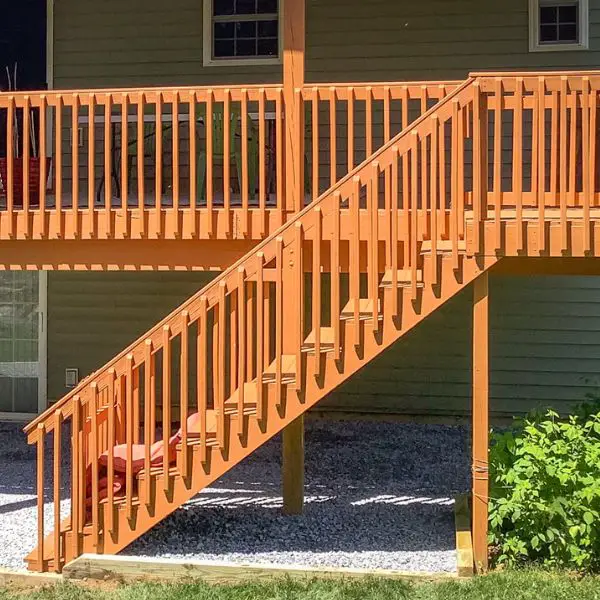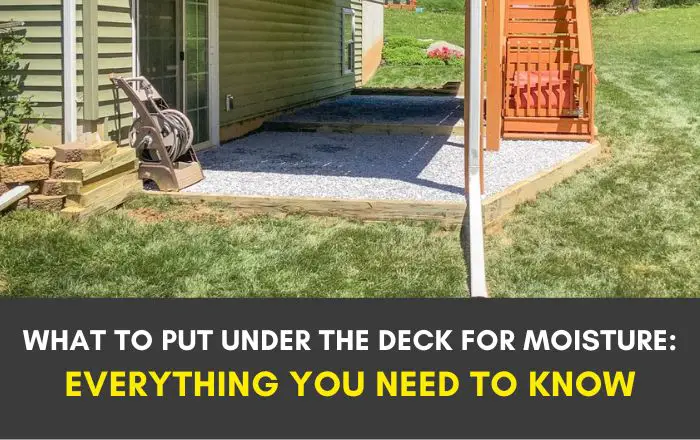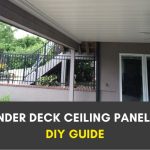To make sure your deck lasts a long time, it’s important to stop moisture from getting trapped underneath it. Moisture can cause rot and damage.
A great way to protect the area under your deck is to cover it with landscape fabric and then put gravel or crushed stone on top.
Avoid anything that might hold moisture or let fungi grow. Having a good drainage system is key. There are other things you can use to control moisture, like deck blocks, rain barriers, or dry wells. These can help keep the ground around your deck dry.
By following these tips, you can help protect your deck from moisture and make sure it stays in good shape for many years.
Using Moisture Barriers Under Your Deck
When it comes to protecting your deck from moisture, you have a couple of options: wet/liquid membranes or rolled/sheet membranes.
Many builders prefer rolled waterproofing membranes because they’re easier to apply and create a more even barrier against moisture compared to the typically cheaper wet membranes.
But no matter which type you choose, following the manufacturer’s instructions is key for the barrier to work effectively.
Before installing a moisture barrier, it’s important to check the ground underneath your deck. Look for any holes or cracks that might let moisture through.
You’ll need to remove the top layer of your deck, which could be made of plastic, stone, wood, or composite tiles, to get a good look at the concrete or wood base below. T
his step helps ensure that the moisture barrier you install is the final line of defense, keeping the important structural parts of your deck safe from moisture damage.
The Importance of Moisture Control Under Your Deck
Keeping moisture away from your deck is really important. If there’s too much moisture, the wood can swell and shrink.
This can lead to the deck becoming weak and damaged over time. You might even see the wood start to twist, bend, or come apart.
Another problem with moisture is that it attracts pests like termites. Once termites get near your deck, it can be tough to get rid of them. They eat the wood, which weakens the whole structure.
To stop water from pooling around your deck, it’s a good idea to build it on a base that drains well, like gravel.

Gravel helps water drain away quickly, instead of letting it sit and soak into the wood. You can also use other things like waterproof flanges, dry wells, or deck blocks to keep the area dry.
In short, to keep your deck safe and in good shape, make sure it has a good drainage system. Without proper drainage, water will just keep collecting around the deck, which can cause a lot of problems.
Keeping Your Deck Dry: Effective Moisture Control Strategies
Controlling moisture under your deck is vital to prevent damage and extend its life. Here are some strategies to help keep your deck dry:
Slope Installation
Building your deck on a sloped surface can help. This way, water flows away more quickly, reducing the chance of pooling. If you go for this option, ensure the deck supports are level to avoid a slanted deck.
Waterproofing Membranes
These are long strips of material, like rolled or sheet membranes, that you apply to the base of the deck. They create a smooth surface and protect the subfloor. They’re easier and quicker to install than liquid membranes and are particularly effective for wooden decks and balconies.
French Drain
A French drain can prevent water absorbed by the deck surface from damaging the wooden joists and foundation. It involves sloping the deck surface towards a gutter, which then channels the water away through pipes.
Advanced Drainage Systems
Modern under-deck drainage systems collect and direct water away from the deck. They can either distribute water into the soil or channel it into drains, keeping the area under your deck dry.
Using Deck Blocks
Concrete deck blocks can elevate your deck from the ground, preventing the supports from rotting due to moisture. They’re especially useful in rainy areas as they keep the deck higher off the ground.
Gravel Layering
Laying gravel under your deck is another great way to ensure proper drainage. The gravel’s texture allows water to drain quickly, preventing it from gathering around the deck’s supports and posts. Gravel also helps prevent weed growth, as weeds need soil to thrive.
By implementing these methods, you can protect your deck from moisture-related issues and ensure its longevity.
Using Non-Organic Material Under Your Deck
When you’re setting up the ground under your deck, it’s important to use non-organic materials. This is because non-organic materials let water pass through without soaking it up.
Organic materials like bark mulch or wood chips can absorb water and start to rot. They can also attract fungi that can damage the wood of your deck.
One good option is gravel. Unlike organic materials, gravel won’t break down over time, so you won’t have to keep replacing it. Once you’ve put gravel under your deck, you’ll just need to rake it now and then to keep it in good shape.
It’s a lot easier to prepare the ground with these materials before you start building your deck. Getting this step done first makes the whole process less of a strain on your back and sets a solid foundation for your deck.
Advantages of Using Gravel and Other Non-Organic Materials Under Your Deck
Using non-organic materials like gravel under your deck comes with several benefits:
Better Drainage
Gravel helps avoid water pooling under the deck. It doesn’t soak up water, so rainwater flows away easily. This prevents dampness, mosquito breeding, wood rot, and extends the life of your deck.
Reduces Soil Erosion
While gravel doesn’t hold water, it slows down its flow, reducing erosion caused by runoff.
Stops Weed Growth: Weeds need soil and moisture to grow.
By covering the ground with fabric or plastic and then gravel, you block these elements, preventing weeds from sprouting between the deck boards.

Protects Deck Footings
The gravel base helps direct water away from the deck’s support posts, reducing the risk of water damage and rot.
Looks Neat
A layer of gravel or a moisture-proof membrane under your deck gives the area a clean and tidy appearance, compared to a muddy or weedy underdeck.
Creates Storage Space
If your deck is raised, the gravel area underneath can be a great storage space. The gravel keeps the area dry, so you can safely store items without worrying about them getting damaged by moisture or rust.
How to Keep Your Deck Dry and Protected
Keeping your deck safe from moisture is important, especially if you live in a rainy area or just want to make sure your outdoor space stays in good shape. Here are some easy methods to protect your deck from moisture damage:
Seal the Substructure
One of the simplest ways to protect the deck’s foundation is by using special tape on the beams and joists. This tape, usually made from butyl, sticks to the wood and acts like a cap, creating a barrier against moisture. It’s especially useful for decks because it also helps keep bolts and screws tight.
Use Ledger Board Flashing
The point where your deck attaches to your house is really vulnerable to water. You can use a wider flashing tape here, which covers the ledger board (the part that connects to the house) completely.
This tape often has a metal lining for extra strength and helps seal any gaps between the ledger and the house.
Choose Composite Decking
Composite decking, a mix of wood and plastic fibers, doesn’t absorb water like regular wood. It’s resistant to moisture and doesn’t warp or split in cold weather.
This type of decking lasts a long time and doesn’t need much maintenance – just some occasional cleaning with soapy water.
Install a Deck Drainage System
If your deck is raised, think about putting in a deck drainage system. These systems are designed to collect and redirect water away from the deck’s substructure.
This not only protects the deck but also creates a dry space underneath that you can use for storage or as an extra outdoor area.
Why Deck Wood Rots
Wood rot on decks is mainly caused by moisture. When wood stays wet for a long time, it starts to decay. This can happen due to mildew, wet rot, or damage from insects.
That’s why it’s important to make sure the wood used in your deck is strong and protected, both during the building process and over time. Typically, the wooden substructure of a deck starts showing signs of splitting and rotting around 8 to 10 years after construction.
While a lot of focus is often placed on the deck’s surface, the substructure – which includes joists, supports, ledger boards, and posts – is equally important.
This is true even if you use composite materials for the deck’s surface because the structure underneath is usually still made of wood. Over time, rain and snow can accumulate between the deck planks, leading to a damp substructure.
Additionally, things like wet leaves stuck between the planks or any lingering moisture can cause long-term damage to the wood.
So, keeping your deck’s substructure dry and protected is key to preventing rot and extending the life of your deck.
Preventing Wood Rot on Your Deck
To stop wood from rotting, the main thing you need to do is keep it from getting wet. The best time to do this is during construction, before you put the deck boards in place.
A good way to protect the wood is to use waterproof flashing tape on the tops of the joists and beams. You can find commercial butyl tapes that are just the right thickness for this job.
These tapes are self-adhesive, making them easy to apply. By putting this tape on before adding any screws or hardware, you create a protective barrier.
This not only helps prevent the wood from rotting by keeping water out but also stops corrosion between the bolts and the wood’s preservatives.
It’s an effective way to waterproof the top of your wood beams and joists, keeping them safe from moisture and extending the life of your deck.
Final Thoughts
To keep your deck safe from moisture, there are several things you can do. It’s a good idea to use a mix of different methods to make sure water is directed away from your deck effectively.
These methods are not only easy to do but also won’t cost you a lot. So, you can try them yourself if you’re comfortable with a bit of DIY.
But, if you’re not familiar with deck building or if it seems like too big of a task, it might be better to get a professional to do it for you. They’ll have the right skills and tools to make sure your deck is protected from water damage properly.
Hina Kanwal is the dynamic force behind Deckfaqs.com, blending her expertise in deck design with actionable insights. Known for her engaging content and practical advice, she empowers homeowners to elevate their outdoor spaces. Her passion and knowledge make her a trusted voice in the world of deck-building.







